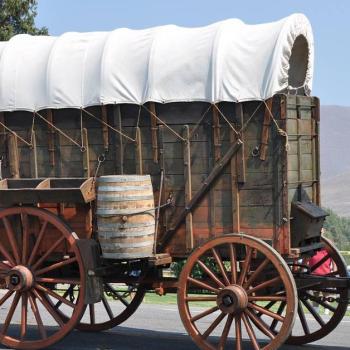Editors' Note: This article is part of the Patheos Public Square on The Spirituality of Children. Read other perspectives here.
Let me take you back in time to St. Simon's Church in Los Altos, California. I attended Mass there as a child, and though the church has since been remodeled, the original structure is imprinted in my memory. In the eighties, there was a huge altarpiece mural showing Jesus on the cross. There was red carpet and there were stained glass windows, large chunks of colored glass with lots of black space in between.
There were also, around the perimeter of the church, the Stations of the Cross. These were detailed paintings done by the same artist who had done the altar mural: fourteen pictures showing various scenes of Jesus' suffering and death, starting with being condemned by Pontius Pilate and ending with his body being laid in the tomb.
I spent a lot of time gazing at those pictures. I gazed at them during Mass with my family on the weekends and studied them at Mass with my classmates on First Fridays. Now, more than thirty years later, they are stored in my memory like old slides in a carousel: every now and then I retrieve them, fire up the mental projector, and review them on the screen of my mind. Even without consciously thinking of them, those scenes are there, a part of the foundation of faith on which my adult spirituality has been built.
Those pictures are proof that if you give a child something beautiful and evocative to look at in church, you are feeding their faith in a way that words can never do.
As a mother, I see this with my own children. Kids have rich visual memories; they notice and remember little details. I will pull out a picture book from my boys' room, an old one they haven't seen in a long while, and they greet it like a photo album of beloved memories. There are certain illustrations that they exclaim over: "I remember that picture! I always used to love it!" (which is a very sweet sentence coming from someone who is only nine).
There is a real power in the visual. Pictures tell stories. They create moods. They make us ask questions: What's happening here? They invite us in: Where would I be in this picture?
As a schoolchild in the early eighties, the power of art to tell a story was having an effect outside of church, too. It was in fourth grade that I first discovered the shelf of Nancy Drew books in the St. Simon School library, books whose hardbound covers presented all sorts of gripping scenes of Nancy in peril. I can still picture the cover featuring Nancy on a rearing horse staring at a ghost stallion on the other side of the paddock, and the one with Nancy opening a trunk in a dusty, candlelit attic. The pictures on those covers captivated me. They were an invitation to engage with a story that would thrill me.
The Stations of the Cross paintings did the same. They captured my attention and drew me into the world of first-century Palestine. They were detailed, colorful, action-filled scenes; they made Good Friday come vividly to life. And while the Nancy Drew books were entertaining while they lasted but ultimately rather forgettable, the lessons of the Stations of the Cross have stayed with me.
In the painting of the First Station, when Jesus is condemned by Pontius Pilate, you saw the coolness of Pilate's white-columned palace and the yellow sunbaked hills beyond. You learned that earthly privilege was comfortable while it lasted but that it could also prevent you from doing what was right. In the Fourth Station, in which Jesus greets his sorrowful mother, you witnessed the bond of parent and child, a love that even suffering and anguish can't break. In the station of Jesus being taken down from the cross, you saw the powerful witness of friends, and learned that sometimes love means walking through the worst with the person you love, even accompanying them beyond death. And though you may have heard similar things preached from the pulpit, it was somehow those pictures that were the most eloquent teachers.
As I sit in Mass now with my own kids, I often see their eyes wander around the church. I see them look at the stained glass, at the statues, at the Stations of the Cross (different from the ones I grew up with, but powerful all the same). And I think about how when kids are sitting at Mass, in one place for an hour with no picture books or screens, they take in what is around them. They study and they memorize, paying attention in a way that they can't do when there are other distractions. So when I see them turn their heads and gaze, I don't redirect their attention to the words of the readings or the homily. I let them look, because I know that seeing can be one step on the road to believing.
5/11/2016 4:00:00 AM




